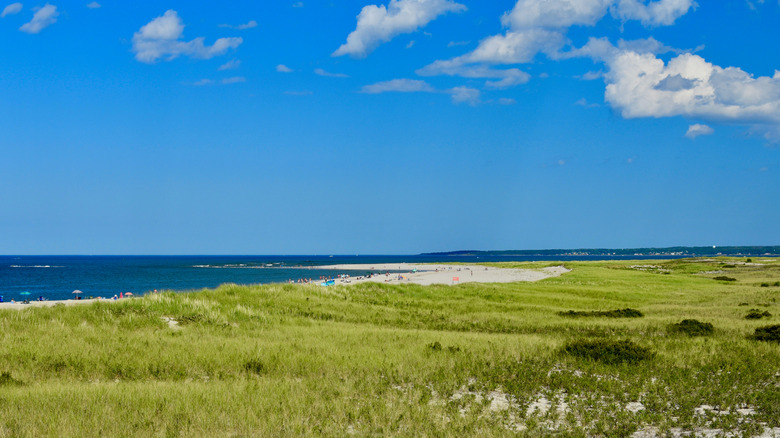The Popular And Beautiful Massachusetts Beach Famous For Its Strange 'Singing' Quality
Known to be one of the most breathtaking beaches on the East Coast, Crane Beach in Ipswich, Massachusetts, has been a beloved oceanfront destination for many years. Featuring miles upon miles of incredible shoreline and conservation land to explore, it's no surprise this is such a busy hot spot in the warmer months, almost as popular as the sandy paradise of Cape Cod just 100 miles to the south. Crane Beach is also just a 50-mile trip away from World's End, a breathtaking park that boasts a pristine coastline and more of Massachusetts' best views. However, what sets Crane Beach apart from these locales, and just about everywhere else, is its shoreline, which you can actually hear. The golden sands found at this beach don't just shimmer — they sing, too.
Singing sand is a rare phenomenon found at beaches in the U.S., including Great Sand Dunes National Park in Colorado, where you can stand on the tallest sand dunes in North America, and other parts of the world. At this point, you may be asking, "What is singing sand, anyway? Why does it occur? And how do I get in on the show?" For answers to those questions, Islands spoke with Professor Cooper, a Professor of Coastal Studies at Ulster University in Northern Ireland, who disclosed all of the fascinating details to us.
About Crane Beach and its mysterious singing sand
The glistening white sand at Crane Beach stretches for four miles along the coast, with a vast 1,200-acre network of forested trails and rolling sand dunes surrounding it. As protected conservation land, the area is home to wildlife habitats and a variety of sensitive ecosystems. As you walk along the shore, you may notice that the golden sand may be covered by a layer of purple. This is the result of small minerals that travel in the waterways from the mountains to the coast, becoming exposed as a result of storms and erosion during the colder months. This alluring color palette is not the only unique feature of the sand at Crane Beach, however. Listen closely, and you may hear the sand sing.
Singing sand may seem like a mystical and strange phenomenon, but it can be easily explained by science, says Professor Cooper. "Singing, barking, and booming sands are quite well known from deserts and beaches around the world," he explained for Islands. "On beaches, the singing noise is produced when hard sand grains move past each other, each producing a squeaking sound, rather like chalk screeching on a chalkboard. The combined squeaks from thousands of grains rubbing against each other creates the characteristic singing sand phenomenon."
But while singing sand may be well known, it is rare. "The sand has to have certain characteristics for this to happen," Professor Cooper said.
How to experience the singing sand at Crane Beach
Crane Beach is one of the few places where all of the conditions align just right to produce singing sand. However, Professor Cooper explains to Islands that you still have to be at the right place at the right time if you want to hear it. "Singing sand is a relatively uncommon phenomenon, restricted to certain parts of certain beaches and sometimes to certain times of year," he told us. In order for sand to sing, all of the grains must be the same size, smooth, nearly sphere-shaped, and dry, as water lubricates them and prevents sound. "The grains also have to be made of hard material, most commonly quartz, he explained. "These combined characteristics are present only on some beaches, and nearly always at the highest, driest part of those beaches."
If you're fortunate enough to be in the area at the perfect time, you'll need to go for a stroll on the beach to hear the sand sing. "On a suitable beach, you do need to cause movement of the sand for it to sing, and walking on it is one way to do so," Professor Cooper said. "Each time you step on the sand, grains get pushed downwards and outwards, and these grains moving past the surfaces of all the surrounding grains is what creates the sound. In other environments, like desert dunes, the same phenomenon can be caused by natural processes, like sand avalanching down the steep side of a dune, but on a beach, walking is the best way to initiate the sound."


